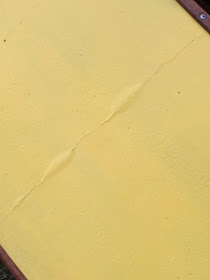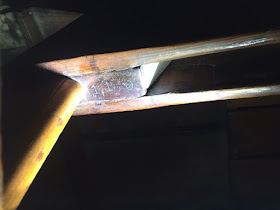 |
| Pegasus plus 3mm ply, loaded on the trailer for the brief ride from my house to Bill's shed. |
Wednesday, December 12, 2018
Pegasus Update
The wheel turns slowly. Some readers may recall that when former Moth Boat World Champion Bill Schill passed away, I was given the remains of Pegasus, his World Championship winning boat. Pegasus was and still is in dilapidated condition. Recently, fellow Moth Boater, Bill B. told me it was time to restore the boat before she was a total loss. We moved the hull to Bill's work shed earlier this month and have started work. We've deconstructed the hull to the saveable parts (basically the keel, centerboard trunk and a few other bits of the boat's original fabric) and are now going the other way with the restoration. Those interested can follow along on Bill's blog. We hope to have the hull rebuilt by spring.
Tuesday, November 20, 2018
Reparing Renegade's mast: shrink wrapped glass sleeve.
I didn't take photos during the glass sleeve and shrink wrap steps because I didn't want epoxy all over my cell phone, but basically the supplier, Soller Composites, has an excellent web site including a video of the sleeve/shrink tubing process:
It all seemed straight forward and I liked the idea that the shrink tubing would give a bit of uniform pressure to the sleeve while the resin kicked off. Sort of like vacuum bagging without the tedium of monitoring of the vacuum system for leaks. I was also hoping that the addition of shrink tubing would translate into minimum sanding. One thing that was an immediate plus was that after applying the shrink tubing over the epoxied area, it was sealed off and I could move the spar inside the garage while the resin kicked without fear of epoxy dribbling on something stored under the long, ungainly mast in my cramped, cluttered garage.
I allowed the resin to cure for several days, due to the cool temps in the garage. When I was initially working with the sleeve material and tubing I learned a couple of things right off the bat. First, one needs to cut the sleeve material a bit longer than the length required in order to allow for the size of the "tube" one is attempting to cover. The larger the tube the longer the excess needs to be--as the sleeve expands, it grows shorter. This probably should have been intuitive but I'm a bit hard headed and not what one would call the intuitive type.
The next thing I learned is that the glass sleeve material is difficult to cut cleanly even with sharp scissors. The photo above shows my result after the resin kicked and after I had removed the shrink tubing. The ends of the sleeve show the fraying of the fiberglass sleeve left by my scissors. In retrospect I think a rotary cutter with a fresh, sharp wheel, and with the sleeve on a cutting board might produce a cleaner result. I have some sleeve material left over so I can experiment with that aspect. Live and learn. Due to the size of this wing mast (~3.0 inches) I used packing tape rather than a zip tie to secure the glass sleeve while wetting out the glass and pulling up the shrink tubing. That seemed to work ok.
I allowed the resin to cure for several days, due to the cool temps in the garage. When I was initially working with the sleeve material and tubing I learned a couple of things right off the bat. First, one needs to cut the sleeve material a bit longer than the length required in order to allow for the size of the "tube" one is attempting to cover. The larger the tube the longer the excess needs to be--as the sleeve expands, it grows shorter. This probably should have been intuitive but I'm a bit hard headed and not what one would call the intuitive type.
The next thing I learned is that the glass sleeve material is difficult to cut cleanly even with sharp scissors. The photo above shows my result after the resin kicked and after I had removed the shrink tubing. The ends of the sleeve show the fraying of the fiberglass sleeve left by my scissors. In retrospect I think a rotary cutter with a fresh, sharp wheel, and with the sleeve on a cutting board might produce a cleaner result. I have some sleeve material left over so I can experiment with that aspect. Live and learn. Due to the size of this wing mast (~3.0 inches) I used packing tape rather than a zip tie to secure the glass sleeve while wetting out the glass and pulling up the shrink tubing. That seemed to work ok.
 |
| A close up of the repaired area. One can see the original split in the wood in the upper right hand side of the mast. |
 |
| Turning the mast over, one can see the luff groove slot which needs to be reopened. |
Tuesday, November 13, 2018
I tawt I taw a Ventnor Moth.
 |
| One of the things I didn't mention in my earlier posts about this year's National Regatta is that Erky's widow, Alma, had decided to offer his vintage division Ventnor Moth Boat for sale. |
 |
| John Z. decided to step up to the plate and is now the new owner of Tweety. |
 |
| The boat is in overall good condition and came complete with two sails, spars and blades. |
 |
| But like all boats approaching 70 years of age, this one has her share of things to correct. |
 |
| But there's nothing here that John can't fix. |
 |
| Although Tweety's original IMCA sail number is unknown, she does have a Ventnor Boat Works production number stamped into the expected place--the forward centerboard trunk log. |
 |
| She'll rest in John's shed until he has time to move her into his workshop. Once fettled, she'll be a welcome addition back in the vintage division racing fleet. |
Monday, November 5, 2018
Repairing Renegade's mast. First steps.
Some readers may recall that during my summer vacation I picked up an old Harry Cates-built Cates design Moth Boat. If not a refresh can be seen here. Work on this boat has been slow due to either 90+ degree heat or torrential rains. Now that fall has arrived the temps and the rain are starting to become a bit more tolerable and so I've pulled out Renegade's mast for a spot of repair.
 |
| The mast has several problems but the biggie is this split in the luff groove starting at the point where the sail feeds into the groove. It involves about 18 inches or so of the mast. |
 |
| Dry run with clamps. |
 |
| Packing tape to catch resin squeeze out. Note the good sized gap remaining even with clamp pressure. |
 |
| Rag on a string to wipe excess resin out of the groove. |
 |
| I used colloidal silica filler for maximum strength. |
 |
| The clamps stayed on over night. I plan to reinforce this repair, taking a tip from a fellow blogger over at the Lingering Lunacy blog, with some fiberglass sleeve. Far less messy than trying to wrap the repaired area with glass tape. More on that once the sleeve material arrives. |
 |
| I decided to test my theory with some household bleach. This is a "before" shot. |
 |
| This is the "after" shot. Hopefully, the damage is limited to the surface layer of the wood. We'll see if a good sanding will get me down to sound wood. |
Friday, November 2, 2018
The Resurrection of Swiss Miss Part Three: Finishing touches
 |
| Another view of the aft end of the hull. |
 |
Forward most bulkhead. |
 |
| Shear clamps. |
 |
| Joe took advantage of a dry spell of weather to paint the exterior of the hull. My old Shelley, Say When can be seen in the background. She's now owned by a junior sailor. |
 |
| A far cry from when I brought her home. |
 |
| Paint dried. Returning to the interior furniture. A new dagger board trunk. |
 |
| This photo shows some of the timber support jig that Joe used to keep the hull in alignment. |
 |
| Another view of the jig, from the bow. |
 |
| The curves in the cut down and lightened bulkheads define the shape of the side tanks. |
 |
| A bit of carbon to reinforce the struts coming diagonally from the king post. Note the small ply gussets used to strengthen the center beam for the fore deck. |
 |
| These curves define the shape of the well deck. |
 |
| Additional framing for the side/seat tanks. |
 |
| Joe first made poster board patterns for the decks and side tanks before cutting ply. |
 | |
| The finished boat at the CMBA Nationals in early October. More about this regatta can be seen here | and here and here . |
Thursday, November 1, 2018
The resurrection of Swiss Miss: Part Two
After Joe got the boat home he quickly decided that the cracked decks and side panels which were providing sanctuary for water logged flotation foam needed go in order to save the hull.
 |
| Port side decks were the first to go. |
 |
| Joe basically gutted the hull. |
 |
| "Wipe Out" No doubt a reference to the tippy nature of this narrow water line design. |
 |
| Once the decks and support structure had been removed, Joe squared the floppy glass hull with timber to keep her from twisting during the installation of bulkheads. |


















